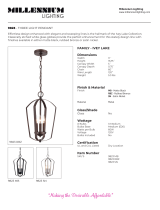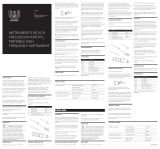Page is loading ...
Page is loading ...
Page is loading ...
Page is loading ...
Page is loading ...
Page is loading ...
Page is loading ...
Page is loading ...
Page is loading ...
Page is loading ...
Page is loading ...
Page is loading ...
Page is loading ...

14 InPro 42XX (i) Series pH electrode
InPro 42XX (i) pH electrode © 04 / 16 Mettler-Toledo GmbH
52 005 365 Printed in Switzerland
1 Introduction ...................................................................15
2 Safetyinstructions ..........................................................15
3 Product description .........................................................15
4 Installation and commissioning .......................................16
5 Operation:Calibrationoftheelectrode
andpHtransmitter .........................................................16
6 Maintenance ..................................................................16
7 Removalofsourcesofmalfunction ..................................17
8 Disposal ........................................................................17
9 Guarantee ......................................................................17
10 Storage conditions ..........................................................17
Contents
en
InPro
42XX (i) Series
pH Electrode
Instruction Manual
InPro,ISMandXerolytareregisteredtrademarks
ofMettler-ToledoGmbHinSwitzerland,theUSA,
theEuropeanUnionandafurthervecountries.
en Instruction Manual

InPro 42XX (i) Series pH electrode 15
© 04 / 16 Mettler-Toledo GmbH InPro 42XX (i) pH electrode
Printed in Switzerland 52 005 365
1 Introduction
TheMETTLERTOLEDOInPro
®
42XX(i)pH-singlerod
measuringcellisalowmaintenance,high-pressure
resistantpHelectrodewithasolidpolymerelectrolyte
(Xerolyt
®
Extra) together with a silver ions barrier.
Thediaphragmisofanopenaperturetype,sothat
direct contact exists between the medium being
measuredandtheelectrolyte.
Please read through these operating instructions
carefully before commissioning, in order to ensure
trouble-freeuse.
2 Safety instructions
When cleaning or calibrating the electrode using
solutionscontainingacidsoralkalisbothprotective
spectaclesandprotectiveglovesshouldbeworn.
Donottouchtheelectrodeattheplug-incontacts,since
electrostaticdischargescandamagetheelectronics.
Werecommendthatyouonlyoperatetheelectrodein
combinationwithoriginalpartsfromMETTLERTOLEDO.
Operationandmaintenanceshouldbecarriedoutonly
by trained personnel and staff who have read and
understoodtheoperatinginstructions.
3 Product description
The inscription on each electrode contains the
followinginformation:
METTLER TOLEDO Manufactureroftheelectrode
InPro
®
42XX i / SG / yyy / zzz Typedesignation;XX=shaft
material,membraneglass;
i=ISMDigital/SG=ancillary
electrode/yyy=rodlengthin
mm/zzz=typeoftemperature
sensor
combination pH Typeofelectrode
pH 0 … 14 pH measurement range
pH 1 … 14 (InPro 4281 i)
0…100°C(130°C) Temperaturerangefor
operation (sterilization)
Order No. 52 00X XXX Order number
SEV14ATEX0168X Identicationandnumber
ofcerticate
IECExSEV14.0025X Identicationandnumber
ofcerticate
IS/I,II,III/1/ABCDEFG/T6 FMtested
Seeinstructionmanual! Instruction(Observethe
operating instructions)
In addition each electrode is allocated a serial
numberontheredpartoftheplug-inheadtoenable
identication.
en

16 InPro 42XX (i) Series pH electrode
InPro 42XX (i) pH electrode © 04 / 16 Mettler-Toledo GmbH
52 005 365 Printed in Switzerland
4 Installation and commissioning
1. While unpacking check the electrode for
mechanicaldamage.Pleasereportanydamage
immediatelytoyourMETTLERTOLEDOsupplier.
2.Removetheprotectivecapandrinsetheelectrode
for a short time with deionized water. If the
electrodehasalreadybeenusedthesensitivepart
canbecleanedwithasofttoothbrushandamild
soapsolution,andthenrinsedforashorttimewith
deionizedwater.Afterrinsingtheelectrodeshould
onlybedabbed.AnyrubbingofthepHsensitive
glasscanincreasetheresponsetimeasaresult
ofelectrostaticchargeaccumulation.
3.Check the spacebehind thepHsensitive glass
forairbubblesandremoveanyairbubblesthat
maybepresentbyshakingtheelectrodeslightly
in a vertical direction.
4.Placetheelectrodeintothehousingasdescribed
intheinstructionsforthehousing.
5.ConnecttheelectrodeandthepHtransmitterwith
thecorrespondingcable(VP6,VP8,AK9).Observe
the connections scheme that accompanies
thecableorthetransmitter.
6. Intelligent ISM
®
sensorssuchasInPro426Xienable
“PlugandMeasure” andexpandeddiagnostics.
Forinstallation,commissioningandoperationof
theISMsystempleaserefertoinstructionsforthe
transmitter, module and cable.
5 Operation: Calibration of the electrode
and pH transmitter
Before a calibration immerse the electrode for
10minutesinapH7.00orpH4.01buffersolution
whilst connected it to the transmitter. A 2-point
calibration is recommended, e.g. pH 7.00 and pH
4.01buffersolutions.Forfurtherdetailspleaseconsult
theoperatinginstructionsforthepHtransmitter.
6 Maintenance
1. After each working cycle the electrode tip and
diaphragm have to be carefully rinsed with
deionized water. Any remaning of the solution
beingmeasuredonthesepartsmustbeavoided
at all costs!
2. Iftheelectrodeisnotinuseithastobestoredwith
theelectrodetipandthediaphragmimmersedin
atankofelectrolyte(9823/3MKClorFriscolyt™
9848).).
en

InPro 42XX (i) Series pH electrode 17
© 04 / 16 Mettler-Toledo GmbH InPro 42XX (i) pH electrode
Printed in Switzerland 52 005 365
3. Iftheelectrodeisstoredinitshousingtheadvices
described under Item 2 apply, although the
electrolytehastobeslightlymodiedforstorage
purposes (2 parts of buffer solution pH 9.2 to
10 parts of electrolyte) in order to avoid any
corrosionofthehousingparts.
4. If an electrode is inadvertently stored in a dry
condition for several days it must be rinsed
forseveralhoursinastandardstorageelectrolyte.
5. Theplug-inheadshouldoccasionallybechecked
forpossibletracesofmoisture.Ifnecessaryclean
itthoroughlywithdeionizedwateroralcoholand
thendryitoffcarefully.
7 Removal of sources of malfunction
Withasofttoothbrushandwateranyresiduescan
easilyberemovedfromtheelectrode.Mildwashing
agents can also be used.
8 Disposal
Itistheuser’sresponsibilitytodisposeofthesensor
inaprofessional manner. The sensor can contain
electroniccomponentsthatrequiredisposalsuchthat
nopersonsortheenvironmentareendangered.
9 Guarantee
Onmanufacturingdefects12monthsafterdelivery.
10 Storage conditions
Werecommendthattheelectrodesarestoredatroom
temperature.
en
Page is loading ...
Page is loading ...
Page is loading ...
Page is loading ...
Page is loading ...
Page is loading ...
Page is loading ...
Page is loading ...
Page is loading ...
Page is loading ...
Page is loading ...
Page is loading ...
Page is loading ...
Page is loading ...
Page is loading ...
Page is loading ...
Page is loading ...
Page is loading ...
Page is loading ...
Page is loading ...
Page is loading ...
Page is loading ...
Page is loading ...
Page is loading ...
Page is loading ...
Page is loading ...
Page is loading ...
Page is loading ...
Page is loading ...
Page is loading ...
Page is loading ...
Page is loading ...
Page is loading ...
Page is loading ...
Page is loading ...
Page is loading ...
Page is loading ...
Page is loading ...
Page is loading ...
Page is loading ...
Page is loading ...
Page is loading ...
Page is loading ...
Page is loading ...
Page is loading ...
Page is loading ...
Page is loading ...
Page is loading ...
Page is loading ...
Page is loading ...
Page is loading ...
Page is loading ...
Page is loading ...
Page is loading ...
Page is loading ...
Page is loading ...

74 InPro 42XX (i) Series pH electrode
InPro 42XX (i) pH electrode © 04 / 16 Mettler-Toledo GmbH
52 005 365 Printed in Switzerland
–
Notes

InPro 42XX (i) Series pH electrode 75
© 04 / 16 Mettler-Toledo GmbH InPro 42XX (i) pH electrode
Printed in Switzerland 52 005 365
–
Notes

Brazil Mettler-Toledo Ind. e Com. Ltda.
AvenidaTamboré,418–Tamboré,
BR-06460-000Barueri/SP,Brazil
Phone+551141667400
e-mailmettler@mettler.com.br;service@mettler.com.br
France Mettler-Toledo Analyse Industrielle S.A.S.
30,Bld.deDouaumont,FR-75017Paris,France
Phone+33147370600
e-mailmtpro-f@mt.com
Germany Mettler-Toledo GmbH
Prozeßanalytik,Ockerweg3,DE-35396Gießen
Phone+49641507-444
e-mailprozess@mt.com
Switzerland Mettler-Toledo (Schweiz) GmbH
ImLangacher,CH-8606Greifensee
Phone+41449444760
e-mailProSupport.ch@mt.com
United States METTLER TOLEDO
ProcessAnalytics
900MiddlesexTurnpike,Bld.8,Billerica,MA01821,USA
Phone+17813018800
Freephone+18003528763(onlyUSA)
e-mailmtprous@mt.com
FormoreaddressesofMETTLERTOLEDOMarketOrganizationspleasegoto:
www.mt.com/pro-MOs
Mettler-ToledoGmbH,ProcessAnalytics,ImHackacker15,CH-8902Urdorf
Phone+41447296211,Fax+41447296636
Subjecttotechnicalchanges
04/2016©Mettler-ToledoGmbH
PrintedinSwitzerland.52005365
www.mt.com/pro
Addresses|Impressum
-
 1
1
-
 2
2
-
 3
3
-
 4
4
-
 5
5
-
 6
6
-
 7
7
-
 8
8
-
 9
9
-
 10
10
-
 11
11
-
 12
12
-
 13
13
-
 14
14
-
 15
15
-
 16
16
-
 17
17
-
 18
18
-
 19
19
-
 20
20
-
 21
21
-
 22
22
-
 23
23
-
 24
24
-
 25
25
-
 26
26
-
 27
27
-
 28
28
-
 29
29
-
 30
30
-
 31
31
-
 32
32
-
 33
33
-
 34
34
-
 35
35
-
 36
36
-
 37
37
-
 38
38
-
 39
39
-
 40
40
-
 41
41
-
 42
42
-
 43
43
-
 44
44
-
 45
45
-
 46
46
-
 47
47
-
 48
48
-
 49
49
-
 50
50
-
 51
51
-
 52
52
-
 53
53
-
 54
54
-
 55
55
-
 56
56
-
 57
57
-
 58
58
-
 59
59
-
 60
60
-
 61
61
-
 62
62
-
 63
63
-
 64
64
-
 65
65
-
 66
66
-
 67
67
-
 68
68
-
 69
69
-
 70
70
-
 71
71
-
 72
72
-
 73
73
-
 74
74
-
 75
75
-
 76
76
Mettler Toledo InPro42 Serie User manual
- Type
- User manual
- This manual is also suitable for
Ask a question and I''ll find the answer in the document
Finding information in a document is now easier with AI
in other languages
- italiano: Mettler Toledo InPro42 Serie Manuale utente
- français: Mettler Toledo InPro42 Serie Manuel utilisateur
- español: Mettler Toledo InPro42 Serie Manual de usuario
- Deutsch: Mettler Toledo InPro42 Serie Benutzerhandbuch
- русский: Mettler Toledo InPro42 Serie Руководство пользователя
- Nederlands: Mettler Toledo InPro42 Serie Handleiding
- português: Mettler Toledo InPro42 Serie Manual do usuário
- dansk: Mettler Toledo InPro42 Serie Brugermanual
- polski: Mettler Toledo InPro42 Serie Instrukcja obsługi
- čeština: Mettler Toledo InPro42 Serie Uživatelský manuál
- 日本語: Mettler Toledo InPro42 Serie ユーザーマニュアル
- svenska: Mettler Toledo InPro42 Serie Användarmanual
- suomi: Mettler Toledo InPro42 Serie Ohjekirja
Related papers
-
Mettler Toledo InPro2000 Operating instructions
-
Mettler Toledo pH electrode InPro4550VP Operating instructions
-
Mettler Toledo InPro 4010 User manual
-
Mettler Toledo pH electrode InPro3030 Operating instructions
-
Mettler Toledo pH Electrodes InPro480X User manual
-
Mettler Toledo pH electrodes InPro325Xi Operating instructions
-
Mettler Toledo DXK pH electrodes (Xerolyt) Operating instructions
-
Mettler Toledo pH electrode InPro® 485Xi Operating instructions
-
Mettler Toledo pH electrodes InPro4501VP and InPro4501 User manual
-
Mettler Toledo pH electrode InPro3100/InPro3100UD User manual
Other documents
-
 Millennium Lighting 9823 Owner's manual
Millennium Lighting 9823 Owner's manual
-
 Weelko Move P02 Owner's manual
Weelko Move P02 Owner's manual
-
Extech Instruments DO603 User manual
-
Aqua Medic 203.00 Operating instructions
-
Extech Instruments EC505 User manual
-
Ohaus STREF1 User manual
-
YSI Science pHT, Pt, G, Micro pH Electrode Owner's manual
-
Hamilton 238364 Operating Instructions Manual
-
Knick SE 554 Owner's manual













































































